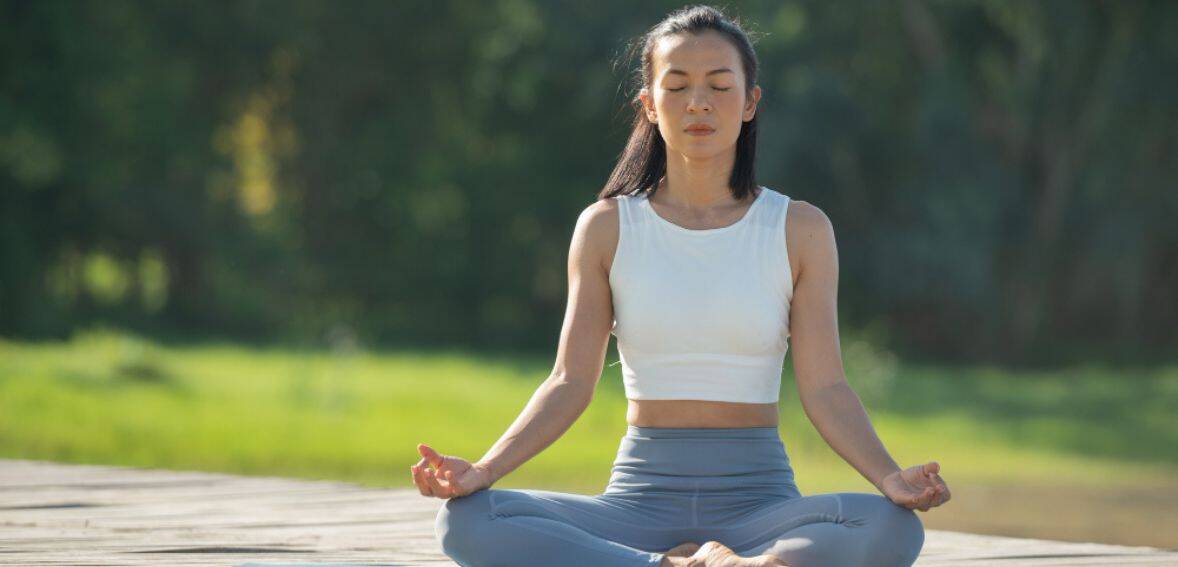
What Is Power Yoga? How to Practice & Energy-Boost Benefits
Power Yoga is an intense, fitness-based style of yoga that involves strength, flexibility, and regulation of your physical health. Great for those who require a more intense workout, it combines movement with traditional poses to build energy and create stamina and overall wellness. Whether you want to build muscle or unlock tension, Power Yoga offers a dynamic, energizing practice for body and mind.
What Is Power Yoga?
Power Yoga is a challenging, flowing yoga style that focuses on strength, endurance, and flexibility. Originating in Ashtanga Yoga, Power Yoga synchronizes breathing with movement in flowing sequences.
Unlike less challenging styles, Power Yoga is a body-sculpting workout, increasing cardiovascular fitness and engaging multiple muscle groups. It’s ideal for those seeking an athletic, fitness-style yoga but also wants to develop mental focus and balance.
Types of Power Yoga
- Dynamic Power Yoga: Dynamic Power Yoga is defined by quick, fluid movements that never allow the body to rest even for a moment. The pose blends into the succeeding one so that it can be considered a cardiovascular exercise to build endurance and muscular strength. Dynamic Power Yoga is ideal for individuals who have to build strength along with flexibility and cardiovascular conditioning using continuous movement.
- Hot Power Yoga: Hot Power Yoga is done in a hot room, usually 95–100°F (35–38°C). The increased temperature provokes circulation, creates deep sweating for detoxing, and enables muscles to stretch more fully. The heat increases the challenge by intensifying concentration, stamina, and calorie burn for class duration.
- Power Flow Yoga: Power Flow Yoga merges the structure of Power Yoga with Vinyasa Flow’s movement-synchronized breathing. The practice is designed for dynamic transitioning through strength postures, supported by conscious breathing. It encourages full-body stimulation, balance, and mental awareness, making it stimulating and grounding.
- Core Power Yoga: Core Power Yoga is oriented towards building core strength and stability. The training directly addresses the muscles of the abdominal area, the obliques, the lower back, and the pelvic floor. Through the strengthening of these core areas, the practitioners achieve enhanced posture, balance, and overall physical control that also translates to enhanced lifestyle activities.
- Restorative Power Yoga: Restorative Power Yoga is a less stressful and more therapeutic variation of Power Yoga. It employs shorter dynamic flows and longer passive resting holds in restorative poses. It’s intended to alleviate stress, facilitate muscle recovery, and enhance flexibility. It’s especially designed for those seeking to balance rigorous training with relaxing meditative movement.
Magnificent Benefits of Power Yoga
- Strengthens Muscles: Power Yoga is an excellent full-body workout that creates lean body mass and muscle tone. The weight of the poses, especially with resistance like planks or chair poses, targets major muscle groups of the arms, legs, back, and core that become stronger and more solid through frequent practice.
- Increases Flexibility: With its demanding sequences and tough spots, Power Yoga highly enhances flexibility. Continuous practice loosens up tight joints and muscles, leading to enhanced range of motion and mobility. Not only does this enhance performance in sports, but it also decreases the likelihood of injury.
- Enhances Cardiovascular Health: Unlike the older, static varieties of yoga, Power Yoga keeps you moving constantly. This constant movement exercises your heart rate, pumping blood and cardiovascular endurance. It is an excellent way to have low-impact cardiovascular training and yet be able to benefit from the meditative benefits of yoga.
- Brings Mental Clarity: Power Yoga emphasizes the synchronization of the movement with the breath, invoking a state of meditation awareness. Power Yoga creates concentration, cultivates the conditions of mind to maintain focus in yoga and in life’s challenges, resulting in greater mental toughness.
- Provides Stress Relief: While demanding, Power Yoga is also extremely grounding. Conscious breath and intentional motion tranquilize the mind, melt tension, and lower levels of cortisol. Students usually experience an aftereffect of calm that lasts considerably beyond the class, which is a good stress-reduction exercise.
5 Super Power Yoga Poses to Build Strength and Endurance
1. Adho Mukha (Downward Dog )
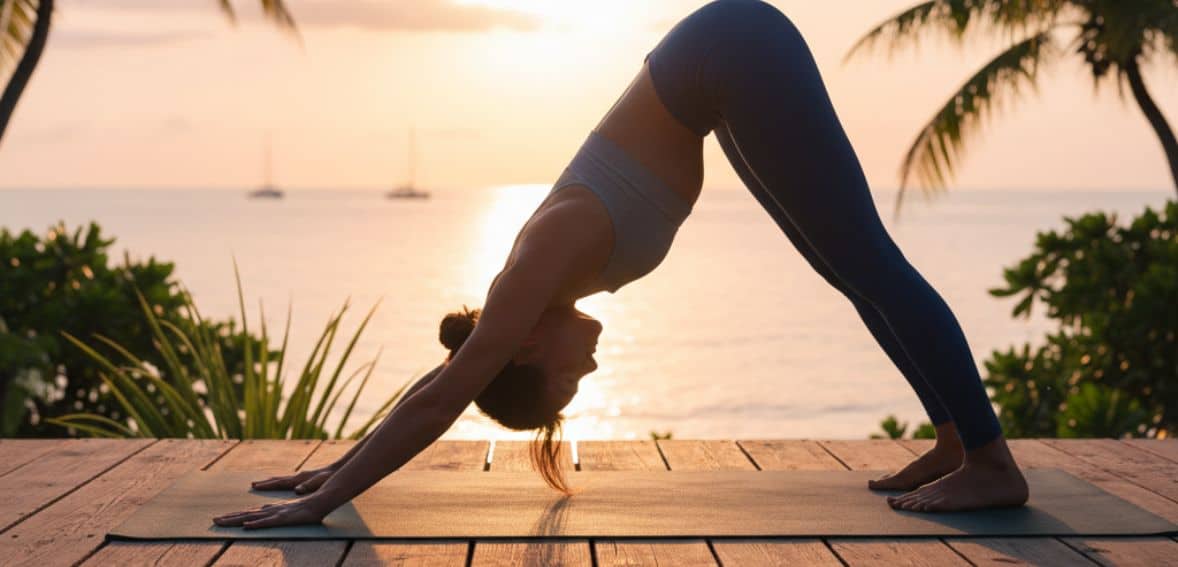
Begin on hands and knees with your hands shoulder-width apart and your hips above your knees. Tuck your toes underneath, bring your knees up, and push your hips forward to form an inverted V shape. Straighten your arms and legs out as you press your heels gently down toward the mat and straighten your back.
Why it’s great: Downward Dog charges the body, extends hamstrings, calf muscles, and shoulders, and firms up arms and legs. It’s active resting time on your Power Yoga sequence.
2. Virabhadrasana II (Warrior II)
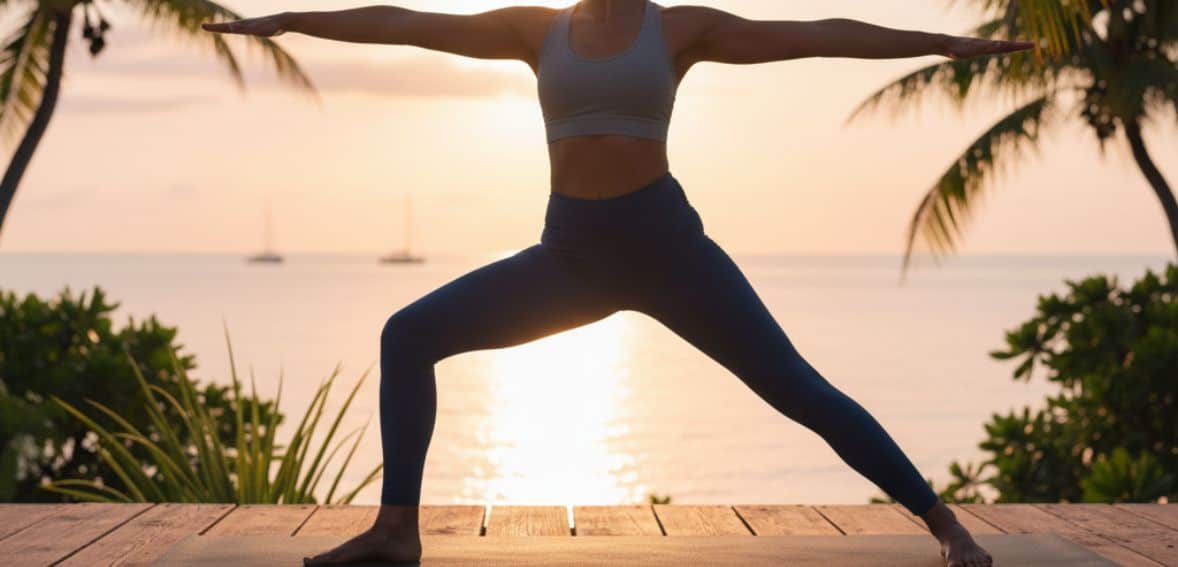
Stand, take one foot back, and bend your front leg at a right angle, keeping your knee above your ankle. Have arms out to the sides, parallel to the ground, and gaze over your front fingertips. Your back foot must be firmly planted, giving a solid base.
Why it’s great:This intense position develops lower body strength, increases stamina, and instills feelings of resilience and confidence. It also frees the hips and develops mental concentration.
3. Phalakasana ( High Plank)
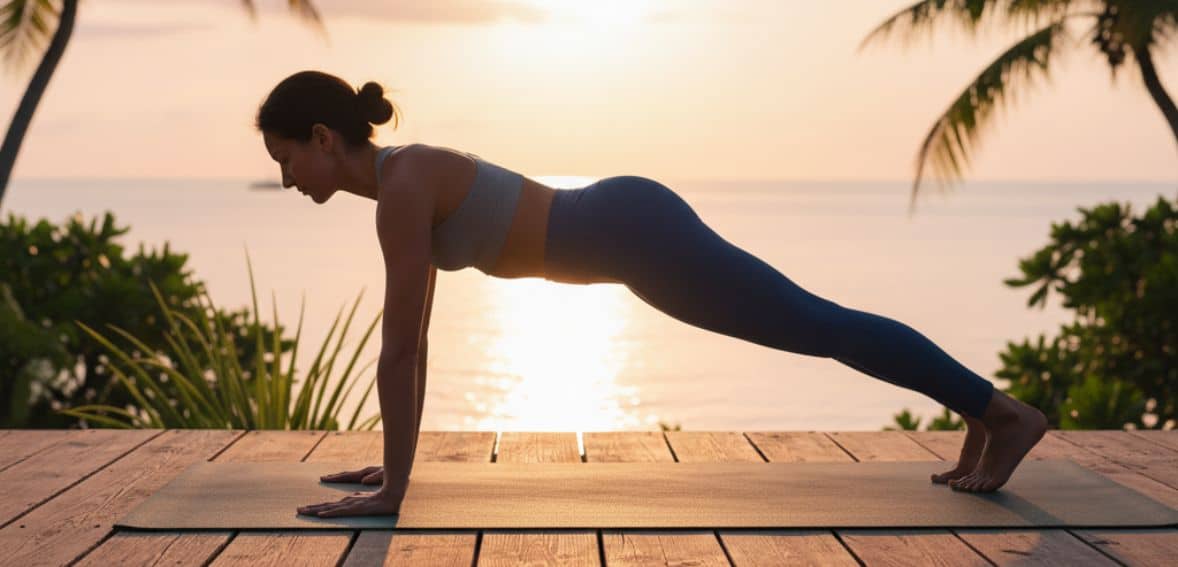
Get into a push-up position with your hands under your shoulders. Activated glutes and core keep the entire body straight from the crown of the head to the heels. Hold firm with even, smooth breathing.
Why it’s so great: The plank is a simple Power Yoga posture that strengthens the core, tones the upper body, and encourages good posture. It’s also a must for building stamina.
4. Utkatasana ( Chair Pose)
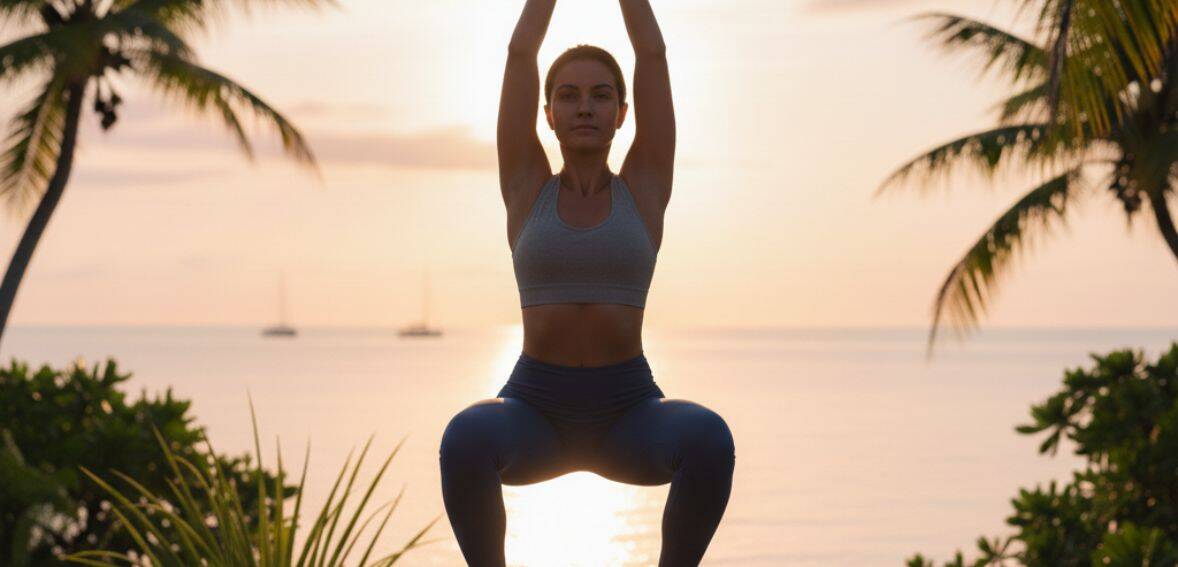
Stand with hips’ width between them, and then bend your knees and lower hips as if you were sitting in a chair that wasn’t there. Rest arms on the head with palms facing the front. Keep chest up and weight on the back of heels.
Why it’s great: Chair Pose challenges legs and gives the core a workout, increasing muscular endurance and strength. It builds mental willpower and focus, allowing you to fight through high waves of intensity.
5. Navasana (Boat Pose)
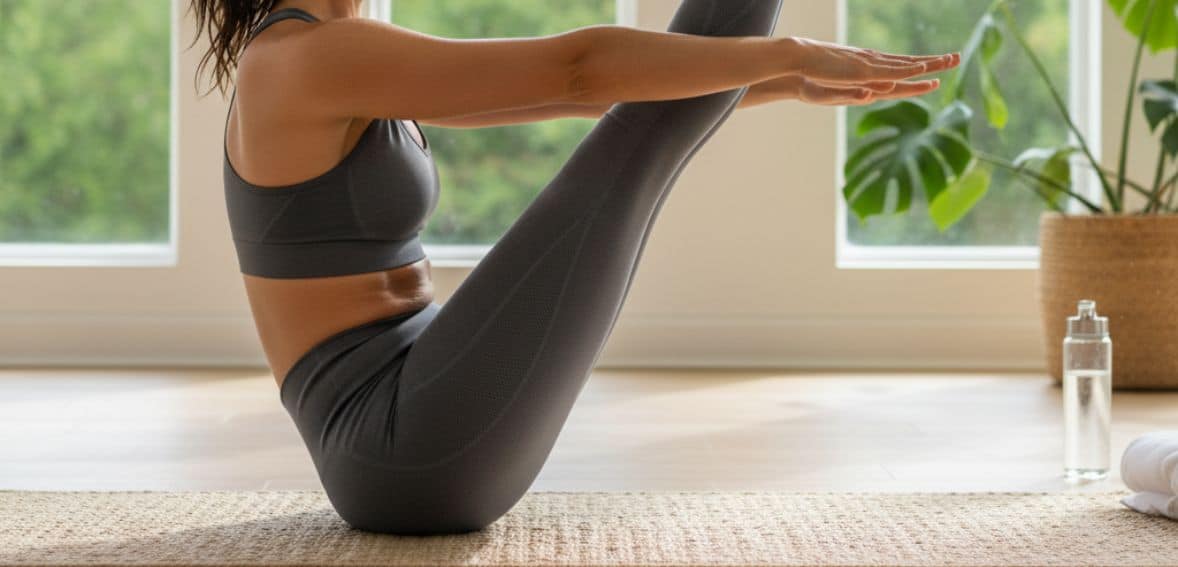
Sit on the mat with folded knees and flat feet. Lean slightly back with your feet lifted off the ground. Stretch your legs straight out such that your body is in the shape of a V, and stretch your arms ahead parallel to the ground. Activate your core and extend your spine.
Why it’s great: Boat Pose requires core strength and balance. It activates the abdomen, hips, and spine and promotes concentration and stability—making it a fundamental pose for the learning of control and internal strength.
Distinguishing Characteristics Between Power Yoga and Other Yoga Styles
- Pacing and Intensity: Power Yoga is a fast-paced, high-intensity workout session with cardio integration. Hatha Yoga styles are slow-moving and meditative and include controlled holding of the poses with relaxation.
- Pose Sequence: Ashtanga Yoga has a fixed sequence of poses each time. Power Yoga, as a modification of Ashtanga, is adaptable—sequences vary based on teacher or class goals.
- Movement and Flow: Power Yoga involves smooth movement from position to position, synchronized with breathing. Hatha Yoga focuses more on standalone postures and alignment with less movement.
- Focus and Purpose: Power Yoga is strength- and endurance-building, whereas Hatha-types emphasize relaxation, stress relief, and quietness.
- Structure and Creativity: There is a creative freedom in Power Yoga, as it is flexible and has a lot of variety. The traditional approaches like Iyengar or Ashtanga are systematic and predictable in their nature.
Weaknesses of Power Yoga
- Requiring a Foundation Level of Physical Fitness: Power Yoga is strenuous. Beginner students who lack exposure to Vinyasa or basic yoga poses won’t be able to keep pace with the pace and complexity of the movements.
- Risk of Injury: Inadequate technique will result in muscle tension or joint issues. Without experience or training, there is a higher risk of overexertion and injury.
- Time Commitment: Class is typically 60 to 90 minutes, which may be challenging for someone with a hectic schedule or for an individual accustomed to brief exercise classes.
Who Should Try Power Yoga?
Power Yoga may be the ticket if you like high-intensity exercise classes or seeking moderate to highly physical fitness practices. It’s also best suited to those who are already accustomed to 60 minutes or more of activity and who have some familiarity with the yoga postures. If you’re looking for a tough, rapid-paced practice that will build strength, endurance, and flexibility, Power Yoga is a good option, however if you are unsure of how to start seek a personal training classes.
How to Get Started with Power Yoga
Start your power yoga by searching for introductory classes in the nearby yoga studios or gym. At times, these classes have been referred to as “Vinyasa yoga,” which has a similar structure to power yoga.
It is a wise idea to speak with the teacher or instructor prior to enrollment so that you will have some idea of the class structure, intensity, and experience level. If you are a complete beginner, it would be better to start with Hatha yoga so that you are learning the basics and gaining confidence before going on to power yoga.
There are plenty of guided practice sessions in the shape of online videos and yoga apps out there for every level of skill. If you have a chronic disease, you are pregnant, or you are injured, please see your doctor first before attempting power yoga.
How to Practice Yoga and Avoid Injury
To practice safely, keep an eye out for proper form and technique on each pose. Don’t try to force your body into a stretch it’s not ready for—pay attention to how it feels. If you’re new or dealing with a pre-existing condition or injury, speak with your doctor first. Always choose variations or modifications that suit your ability, and feel no inhibition in using props like blocks or straps to support your alignment. Practicing with a good teacher can also prevent injuries and lay a good, safe foundation.
Power Yoga vs. Vinyasa Yoga
Understanding Power Yoga and Vinyasa Yoga
Power Yoga and Vinyasa Yoga are both flowing movement techniques, yet they differ in intensity and concentration. Power Yoga is strength-and-speed oriented, ideal for building muscle and endurance. Vinyasa Yoga is committed to flowing, breath-synchronized motion between poses, a more fluid and meditative practice. Both promote fitness and awareness but for those who require a high intensity speed workout then Power Yoga is good, while Vinyasa offers a more balanced, flowing flow of mediating movement practices.
Difference in Techniques and Movements
Power Yoga is more about stamina building and strength acquisition through fast, intense movements. Power Yoga includes high-intensity sequences with minimal rest time in a bid to push the physical limits and build stamina. The asanas are not held for long periods, and the emphasis is on maintaining movement and challenge.
On the other hand, Vinyasa Yoga focuses on transitioning from one posture to another in harmonious synchrony with breath. The transitions are flowing and smooth, and they create a meditative rhythm. It is more flexible to accommodate variation and creativity in class scheduling so that every class is unique. While Power Yoga may include more advanced postures like arm balances and speedy transitions, Vinyasa balances action with breathing and typically lengthens poses to build control and focus.
Physical Benefits of Power Yoga and Vinyasa Yoga
Power Yoga builds strength, endurance, and flexibility with speedy, high-level movement. It strengthens the cardiovascular system through cardiovascular workout and core strength, which is ideal for those who need an intense workout. Vinyasa Yoga focuses on flowing, breath-coordinated movements that promote balance, coordination, and flexibility. Its consistent movement also protects joints and offers gentle aerobic gains, so it is a calming yet effective practice.
What to Expect in a Power Yoga Class
- You’ll Break a Sweat: Power yoga is intense. With constant movement and challenging poses, you’ll definitely sweat. Hydrate well and keep a towel handy during class.
- It’s Physically Demanding: Expect your muscles to work hard. Holding poses for longer and flowing through sequences quickly builds strength and flexibility. Beginners are welcome—just go at your own pace.
- It Tests Your Focus: Power yoga also tests your mental stamina. You’ll require concentration and breath control in order to remain present and push through demanding sequences.
- It Increases Mind-Body Awareness: It’s intense, but power yoga began with mindfulness. The coordination of movement and breathing deepens your concentration and permits the release of tension.
- You’ll Get Energized: When you’re done, you’ll be revitalized, mentally sharpened, and refreshed. It is a physical exercise that gets you moving and sets you up to tackle the day.
Conclusion
Power Yoga is not merely a physical practice—it’s an energetic practice that recharges the body, clears the mind, and rejuvenates levels of energy. Through the combination of breath and movement, it presents a balanced method of fitness and awareness. Whether a seasoned yoga practitioner or simply a newcomer seeking a serious means of maintaining physical fitness, Power Yoga can be a strengthening addition to your practice. If practiced on a regular basis, you will notice an enhancement in strength, flexibility, and a general sense of mental acuity.
FAQs
Is Power Yoga for Beginners?
Yes, but beginners may begin with a beginner-level class or introductory Vinyasa to establish a solid foundation.
How frequently do I need to practice Power Yoga?
3–5 times weekly is ideal to build strength and consistent gains without overtraining.
Does Power Yoga help me lose weight?
Yes, its high-intensity, full-body movements can burn calories and boost metabolism, enabling you to maintain weight.
What is the difference between Power Yoga and regular yoga?
Power Yoga is more intense, faster, and fitness-based, while regular yoga might be more relaxation- and awareness-based.
Should I employ any special equipment in order to practice Power Yoga?
Nothing more than a high-quality yoga mat, water, and towel; blocks or straps are helpful but unnecessary.
